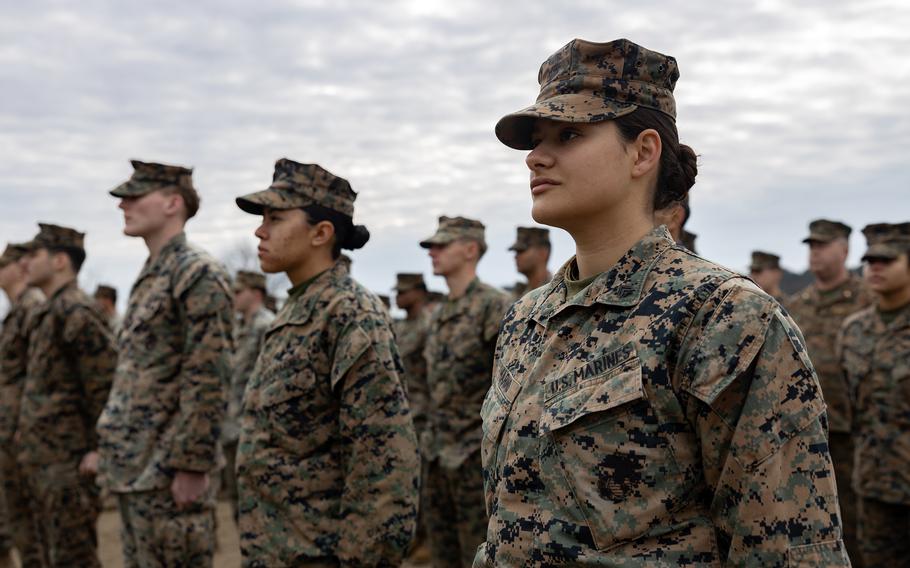
Cpl. Natalie Marino and other members of the 31st Marine Expeditionary Unit stand at attention during the opening ceremony for the Iron Fist exercise at Camp Ainoura in Sasebo, Japan, Feb. 25, 2024. (Christopher Lape/U.S. Marine Corps)
U.S. Marines and sailors and Japanese troops have begun three weeks of amphibious training amid concern in both countries about Chinese military moves around Japan and Taiwan.
Troops will practice recapturing an island during the Iron Fist 24, which is “focused on island defense,” a spokesman from Japan’s Ground Staff Office said by phone Tuesday. Japanese government spokespeople typically speak to the media on condition of anonymity.
The commander of Japan’s 2nd Amphibious Rapid Deployment Regiment, Col. Hajime Tsuji, and the head of the Okinawa-based 31st Marine Expeditionary Unit, Col. Matthew Danner, gave troops a peptalk Sunday during Iron Fist’s opening ceremony at Camp Ainoura in Nagasaki prefecture.
“By comprehensively practicing a series of actions, we will improve the ability of Japan and the U.S. to carry out joint amphibious operations for the defense of islands in the southwest region and demonstrate the strength of the unity of the Japan-U.S. alliance,” Tsuji told the troops.
Iron Fist marks a milestone as U.S. forces integrate more deeply with the Japanese marines, Danner said in a Feb. 5 Marine Corps statement.
“With each bilateral event that we, as the 31st MEU, have participated in, I’ve witnessed our combined knowledge and ability to rapidly integrate grow significantly,” he said in the statement.
Camp Ainoura is a few miles from Sasebo Naval Base, homeport of the amphibious assault ship USS America, which is participating in the drills.
Japan in recent years has strengthened its amphibious capabilities in response to a rapid Chinese military build-up, aggression toward neighboring countries and a promise by Chinese President Xi Jinping to reunify Taiwan, by force, if necessary.
Iron Fist, in its 18th year, is taking place on Kyushu, the southernmost of Japan’s four main islands, on Okinawa and at sea, according to the Marines’ statement.
The three-week exercise focuses on advanced marksmanship, amphibious reconnaissance, fire and maneuver assaults, bilateral logistics and medical support, and fire support operations, such as mortars, artillery and close-air support, the statement said.
The key training event is a bilateral amphibious operation March 12 on Okinawa, the statement said.
Iron Fist, which concludes March 17, involves 2,100 U.S. and Japanese personnel, Capt. Pawel Puczko, a 31st MEU spokesman, told Stars and Stripes in an email Tuesday.
Participating U.S. units and vessels include Combat Logistics Battalion 31, Battalion Landing Team 1/1, Marine Fighter Attack Squadron 121, U.S. Navy Amphibious Squadron 11 and the amphibious transport dock USS Green Bay, Puczko said.
Marine Medium Tiltrotor Squadron 265 Reinforced is supporting the exercise with CH-53 Sea Stallion, UH-1Y Venom and AH-1Z Viper helicopters, Puczko said by phone Tuesday.
The squadron’s MV-22 Ospreys remain grounded, along with all U.S. military Ospreys, while the Pentagon investigates a tiltrotor crash that killed eight Air Force crew members Nov. 29.
Japanese units and vessels include the 2nd Amphibious Rapid Deployment Regiment, Landing Ship Division 1 and the tank landing ship JS Kunisaki, he said.
The drills include 600 Japanese soldiers, 200 Japanese sailors, 700 U.S. Marines and 600 U.S. sailors, the Ground Staff Office spokesman said.
The United Kingdom, Germany, France, Australia, the Philippines, and the Netherlands have sent observers to the exercise, according to the spokesman.